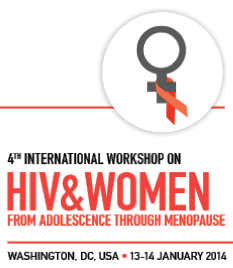High rates of pregnancy in HIV positive women in Zambia and South Africa
1 February 2014. Related: Conference reports, Women's health, Pregnancy, Intl Workshop on HIV and Women 4th 2014.

Polly Clayden, HIV i-Base
Unmet need for family planning is high in sub-Saharan Africa and preventing unintended pregnancies is a priority for maternal health and eliminating vertical transmission.
Two presentations at the 4th International Workshop on HIV & Women showed high rates of pregnancy among HIV positive women in Zambia and South Africa.
Unintended pregnancies and limited contraceptive use in rural Zambia
S Okawa presented findings from a study conducted to assess unintended pregnancies and contraceptive use in HIV positive pregnant women, and to look at the associated factors in rural Zambia.
This was a prospective cohort study from July 2011 to March 2013 of 371 women accessing PMTCT services at 11 health centres in Chongwe district.
Data was collected through face-to-face interviews in which participants were asked about their background characteristics, pregnancy intention, contraceptive use, and reasons for not using contraceptives.
About half of the women already knew their HIV status before the current pregnancy, 51%% were less than 30 years old, 67% had less than 8 years of education, 83.% were married, 38.% had more than 4 children, and 63% were unemployed.
About a third had HIV positive partners and just under half had partners in permanent employment. The majority (88.5%) of women had disclosed their HIV status to their partners, and 19% had experienced domestic violence.
A total of 187/371 (50%) reported unintended pregnancies, of those 101 (54%) did not use any contraceptive. Reasons for not using contraception are listed in Table 1.
| Reason | n | % |
|---|---|---|
| Did not want to use | 45 | 45.9 |
| Did not ask health worker | 42 | 42.9 |
| Don’t know any | 31 | 31.0 |
| Afraid of side effects | 26 | 26.8 |
| Did not know where to get it | 24 | 24.5 |
| Partner did not want to use it | 23 | 23.5 |
| Religion did not allow use | 6 | 6.1 |
| Traditional contraception instead | 6 | 6.1 |
In multivariate analysis, unintended pregnancy was associated with mother older than 30 years AOR 1.78 (95% CI 1.12 to 2.84), p=0.02; unmarried status AOR: 3.79 (95%CI 1.48 to 9.33), p=0.01; and partner with non-permanent AOR 1.63 (95%CI 1.03 to 2.57), p=0.04.
Only unmarried status was associated with non-contraceptive use AOR 2.01 (95%CI 0.99 to 4.09), p=0.05.
The investigators concluded: “There is an urgent need to increase contraceptive coverage among HIV- positive women and their partners who are not considering further pregnancies.” “Provision of family planning services at antiretroviral therapy clinic and PMTCT services could increase contraceptive coverage”, they added.
Increasing numbers of young pregnant women in a South African metropolitan district
In a related presentation Bonaventura Egbujie from Kheth’Iimpilo, Cape Town, showed findings from a cohort study that took place at three facilities in the Nelson Mandela Metropolitan District, Eastern Cape between January 2009 and June 2012. The study investigated the age distribution of HIV pregnant women over time in order to estimate age-specific prevalence trends using individual level electronic clinical data.
A total of 1455 HIV positive women were included of a median: age 26.8 years (IQR 2.9 to 36.6); baseline CD4 count 351 cells/mm3 (IQR 235 to 509) and gestational age 21 weeks (IQR 16 to 26). At presentation 65% were unaware of their HIV status and 12% were on ART. Of the total: 111 (7.5%), 225 (15.3%), 754 (51.2%) and 383 (26%) presented in 2009, 2010, 2011 and 2012, respectively.
The analysis revealed the proportion of women aged 15 to 24 years almost doubled between 2009 and 2012, from 27.9% (95% CI 19.8 to 37.2%) to 41.1% (95% CI 36.0% to 46.2%), p= 0.0003. The proportion of women aged 18 to 21 years more than doubled from 8.1% (95% CI 3.8% to14.8%) in 2009 to 18.1% (95% CI 14.3% to 22.4%) in 2012, p= 0.0015). The proportion of adolescents aged <18 years increased by almost 70% from 3.6% (95% CI: 0.1%-7.1%) to 6.1% (95% CI: 3.7 to 8.6%) during the same period, p= 0.084.
Factors associated with these trends are shown in Table 2.
| Age (years) | <18 | 18-21 | 22-24 | >24 | p-value |
|---|---|---|---|---|---|
| HIV status unknown (%) | 93 | 81 | 69 | 57 | <0.0001 |
| On ART | 2 | 3 | 5 | 18 | <0.0001 |
| Chooses formula feeding (%) | 8 | 16 | 31 | 38 | <0.0001 |
| Infant 6 week HIV PCR positive (%)n=450 | – | 4.1 | 7.1 | 1.9 | 0.05 |
The investigators concluded that increasing proportions of younger women with HIV are presenting at facilities in this district. Although Dr Egbujie expained that neither HIV incidence or prevalence cannot be directly measured from these data, these trends suggest increasing HIV incidence among younger women and/or increasing youth pregnancy.
Very young women were less likely to be aware of their HIV status or be on ART and had higher vertical transmission rates.
“Factors driving these findings should be investigated, and intensified HIV prevention and family planning efforts showed be directed toward youth and younger women in this area” he said.
References:
- Okawa S et al. High proportion of unintended pregnancies and limited contraceptive use among HIV- positive women in rural Zambia. 4th International Workshop on HIV & Women, Washington DC. 13-14 January 2014. Oral Abstract_13.
http://regist2.virology-education.com/2014/4hivwomen/docs/18_Ishikawa.pdf - Fatti G et al. Increasing Numbers of Young Pregnant Women with HIV in a South African district. 4th International Workshop on HIV & Women, Washington DC. 13-14 January 2014. Oral Abstract_14.
http://regist2.virology-education.com/2014/4hivwomen/docs/19_Egbujie.pdf

